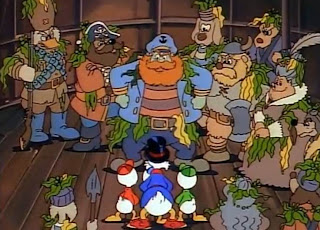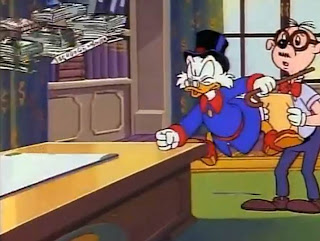Along with "Once Upon a Dime," "Curse" represents one of the very few times that DuckTales attempted to tell its audience anything about Scrooge's back story. In this case, writer Anthony Adams' spare approach to the task is definitely a matter of "less is more." I would defy anyone to argue that the ramshackle pile of frequently questionable incidents heaped up during the course of "Once Upon a Dime" proves more aesthetically successful than Adams' simple explanation that Scrooge's parents were "poor, simple [Scottish] farmers who just wanted to start over someplace else" and took wee "Scroogey" with them to America. If you don't subscribe to Don Rosa's Revised Standard Version of Scrooge's life and just want bare facts, mon, I can't see anything egregiously wrong with Adams' ultra-simplified version of the story. Some of the details presented on screen, however, tend to complicate matters.
Let's pause at the threshold of Cottage McDuck for a moment to compare two post-Barksian versions of the whippersnapper Scrooge:
The Rosa version of bootblack Scrooge is, of course, supposed to be somewhat older than the six-year-old cutie in the skirt, er, kilt. Also, the DuckTales tyke is more heavily influenced by stereotypical images of Scottish garb. (Notice the cent sign on Scrooge's belt buckle; isn't that somewhat premature?) Still, I find much to like in both of these portraits. I wish that they could be meshed together in a single biography in some manner.
It's actually quite peculiar that the portrait of six-year-old Scrooge should have been left behind in Cottage McDuck... along with a lot of other possessions. One would think that "poor, simple farmers" would want to take everything that they could with them in order to facilitate the transition to a new life overseas. Still, there are possible explanations for leaving so many goods behind. What I can't buy is Scrooge leaving behind his first piggy bank, the very one with which he started his "life of saving." You go to all the trouble of setting a booby trap to catch would-be thieves in the act, but then you don't even bring the bank with you when you depart?! Perhaps Adams included this improbable scene to provide us with a sight gag in an episode that is almost totally humorless otherwise.
"And THAT's for leaving me to gather dust!"
The bank business is a mere annoyance; the slipshod manner in which the methods of operation of the "glowing ghost hound" that has "cursed" Castle McDuck for years are presented is a more serious problem. Consider Scrooge's claim that, according to the legend told to him by his mother, "the hound won't cross the river." That would presumably mean that the beastie would stay on the far bank of the body of water glimpsed in this shot of the castle:
But, in the episode's opening scene, we see the hound appear next to a different body of water, one that looks very much like a pond or loch, er, lake:
I suppose that it's possible that the river empties into the lake at some point, but I suspect that this appetizer was served up simply to establish the fact that the hound "terrorizes" the local peasants and shepherds (including William, the Pat McCormick-voiced fellow who is frightened away here). Which, when you think about it, would be difficult to do if the hound were restricted to so snug a perimeter about the castle. Why haven't the locals figured out that the hound only appears in certain locations and then tried to AVOID those locations?
Give the animators (and the inevitable Frank Welker) credit: the hound, on the brief occasions when it appears, is genuinely menacing. One can easily see how Scrooge's mother's verbal ability to make the hound seem real might have sunk deep roots in Scrooge's psyche. Even so, Adams could have made this episode resonate a bit more by allowing Scrooge to be a little more conflicted on the matter of dealing with the hound. The dramatic potential inherent in Scrooge's "facing of fears" directly linked to his heritage and roots surpasses anything seen in the later episode "Nothing to Fear." Instead, after some initial quivering and shivering when pressed by the eager kids to explore the castle, and immediately after his first "close houndcounter," Scrooge suddenly turns on a dime (not Old #1 -- this is a different origin story) and turns into a determined detective as the Ducks investigate the nocturnal druid rite. All honor to Scrooge for overcoming his ancestral willies, but perhaps this scene could have been shifted to a later point in the episode, displacing some less important material and allowing Scrooge more time to work out his personal demons. There wasn't any compelling reason for Webby to get trapped behind a wall and explore a secret passage, after all...
The "trapping scene" is the best scene of the episode, though I'm in agreement with Greg that a lot of the logistics are screwy. How could only one Druid have fallen out of the carpet after it had been lifted to the rafters and the hound had torn open a hole in it? Even more to the point, how the heck did the Ducks manage to rig up that complicated system of pulleys and ropes? Yes, I know, Junior Woodchuck Guidebook, yadda yadda. But just answer me this: to what are the pulleys attached in the scene below? It would have required someone(s) to literally hang from the ceiling in order to pull this off. This reminds me of an episode of the old Spiderman animated series from the 60s, in which Spidey swung through scenes while shooting web-ropes attached to... well... um...
Now, I'm not really offended, as GeoX was, by the idea of the Druids agreeing to let the castle become a tourist attraction. The goal of the agreement, after all, was to have the best of both worlds, to allow Scrooge to (partially) reclaim his heritage and to let the Druids continue to hold their rites in their sacred spot. The REAL problem is those damned T-shirts and balloons! That, I have a hard time imagining the Druids countenancing. Based on Adams' apparently healthy level of respect for the power of myth and legend, both in his own personal creations and his scripts for DuckTales, I frankly find it surprising that he would find this scene acceptable. The scene could have simply shown the tourists viewing the castle and the Druids outside discussing their arrangement with Scrooge, and that would have been perfectly jake with me and, presumably, with anyone whose nose may have wrinkled at the rancid smell of a "capitalist sellout" here. I certainly hope that this scene wasn't forced upon Adams' script by one of those infamous "executive decisions" that gummed up several other Disney series I could name.
So -- not as good as I originally remember it being, perhaps, but still quite watchable, albeit relatively prosaic.
.
.
.
"DuckBlurbs"
(Greg) Webby backs up into a circular brick wall and then the brick wall consumes her. No really; I'm as shocked as you are... Scrooge ties the rope to the candlesticks on the wall and tries to speak to Webby; but no response as he panics. Huey wonders where she went. Scrooge goes to the consuming brick wall and does notice her muffled voice as Webby is as confused about her location as I am. We do some dark promos and pushing around for a secret passage button; but no dice from the nephews as Webby is getting frightened by the dark by the second. Scrooge and company decide to go to the fireplace since that passageway they know about. We then cut to inside the dark passageway (which is so lit that it breaks logic on being so dark to Webby) as Webby calls for Scrooge and gets no response.
For a "dark passageway," that cul-de-sac into which Webby stumbled was fairly well lit! Also remember that the "nocturnal" hound's initial appearance at Silas McDuck's castle-warming party took place at sunset, rather than after dark. Light and darkness shouldn't be that hard to keep straight, right?
Next: Episode 20, "Send in the Clones."






























































